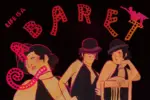This summer, I had the privilege of being able to stroll through New York City. As I walked along the street, I saw young people chattering over mimosas on outdoor patios, and I smelled the sweet malodor of garbage bags stewing on the sidewalk. One evening, my family and I escaped the heat and attended a Broadway show. We ducked under the Schubert Theater marquee for an evening performance of “To Kill a Mockingbird.”
After a hot day exploring new neighborhoods, “To Kill a Mockingbird” was comforting and familiar. Like many North American kids, I had encountered Harper Lee’s celebrated novel before. I dissected passages about Maycomb, Alabama, in small reading groups during eighth grade English. Teachers used the text to prime our young minds for discussions of empathy and American race relations.
Yet, in similar rhythm to the rest of my trip, the Broadway production fused both the familiar and new. Acclaimed screenwriter Aaron Sorkin (creator of “The West Wing” and “The Social Network”) had adapted the story, and Bartlett Sher directed the staging, with actor Jeff Daniels as Atticus Finch. This version of “To Kill a Mockingbird” would challenge my conceptions about a book that I thought I already covered.
This reimagining of the play underscores the novel’s central theme of race and Southern corruption; yet, it also foregoes some of the novel’s coming-of-age elements. This younger, freshly-hatched “Mockingbird” left me examining the classic tale with a more critical eye.
“To Kill a Mockingbird” follows two stories over one hot Alabama summer. The first covers Jean-Louise “Scout” Finch as she comes of age with her sibling and friends. Through her lens, we see a larger storm brewing in the outside world.
And her father, attorney Atticus Finch, undertakes the controversial task of defending Tom Robinson, a black man falsely accused of raping a white woman.
At the beginning of the show, a pianist and a banjoist plant their feet on opposite ends of the stage. The two musicians provide a soft, haunting melody in the background as the plot unfolds onstage.
The set is minimal. Vines and greenery hang from the ceiling of the theater. The furniture on set — from the jury stand in the courtroom to Atticus’ rocking chair on the front porch — give the stage an earthy, sepia atmosphere.
Sorkin’s script centers the action primarily on the courtroom. The action follows the proceedings of Robinson’s trial while intermittently flashing to other scenes during the summer. In the courtroom, one of the jury stands is full, while the other remains empty the entire performance.
This choice to keep one jury stand empty is not only visually striking, but it also has symbolic significance. In Lee’s novel, a key scene occurs where every black person in the courtroom stands up and applauds Atticus Finch for defending Robinson. Sorkin chose to omit the scene in his adaption because he believed it gave too much credit to the “white liberal guy.”
Sorkin’s Atticus Finch is also reinterpreted. “To Kill a Mockingbird” has often been criticized for oversimplifying race relations and glorifying its lawyer protagonist. Here, Daniels’ performance highlights some of the attorney’s more human flaws.
For example, Sorkin also emphasizes the flaws of unyielding idealism. Finch sees the best in everyone. The protagonist drives several hours to inform the Robinson family of Tom’s death, and he waxes poetic about the importance of empathy to his children.
However, he refuses to enact violence on Bob Ewell when Ewell threatens Finch’s family, and Finch does not recognize how the odds of the trial are systemically rigged against him.
Other changes give the novel’s black characters more agency. Tom Robinson expresses apathy in early scenes about knowing that his fate is sealed from the moment of accusation. Sorkin portrays Tom as having a quiet sense of resignation.
Another major change is the Finch family housekeeper, Calpurnia, who is played by a fiery LaTanya Richardson Jackson. In the book, Calpurnia is a quiet, docile domestic figure. On stage, Calpurnia educates the Finch children about race, and she is a vocal activist against racial injustice.
While Daniels plays Atticus Finch with composure and valor, not every aspect of this revival clicks into gear. The three children — Scout, Jem and Dill — are central to the novel, especially to its theme of coming of age. This production relegates them to the role of a Greek chorus.
For a novel purist, the choice to turn the children into mere narrators is alarming. After all, the children are the book’s focal point. We learn about racial injustice through their innocent eyes.
In the stage adaption, however, the role of the child characters becomes lost in translation. Rather than including scenes from the book about Scout and Jem at school, the characters’ dialogue mentions them in passing. These anecdotes can seem like jarring departures from the plot.
Even more perplexing, the production includes adult actors playing the kids. Broadway superstar Celia Keenan-Bolger portrays Scout with dry, deadpan humor, and Gideon Glick provides some much-needed comic relief as the zany, off-kilter Dill Harris.
Despite some strong acting, I could not shake the strangeness of grown-ups starring in a story about childhood innocence.
The dialogue only worsens this incongruity. With his witty one-liners, word-smithery and various walk-and-talks, Sorkin has an iconic style of dialogue that suits Finch well, but such sophisticated language falls flat on the child characters, who seem even more adult when they start crafting complex puns.
I walked into “To Kill a Mockingbird” expecting the comfort of watching a story that I already knew. I was excited to see the heroic Atticus Finch commanding the courtroom, the childhood banter between Dill and Scout as they lazed away summer afternoons and the twisty revelation of Boo Radley’s identity at the story’s end.
While many of these wishes came to life on stage, they were also complemented with scenes that challenged the story’s blind faith in Atticus Finch’s heroism.
In an age where idealism continues to fuel bipartisanship, perhaps a sobering take on Atticus Finch is necessary to understand the dangers of unchecked trust in other people.
And perhaps this new, more critical examination of the main character of “To Kill a Mockingbird” allows a classic to feel contemporary. Perhaps, it teaches an old mockingbird new tricks.
















